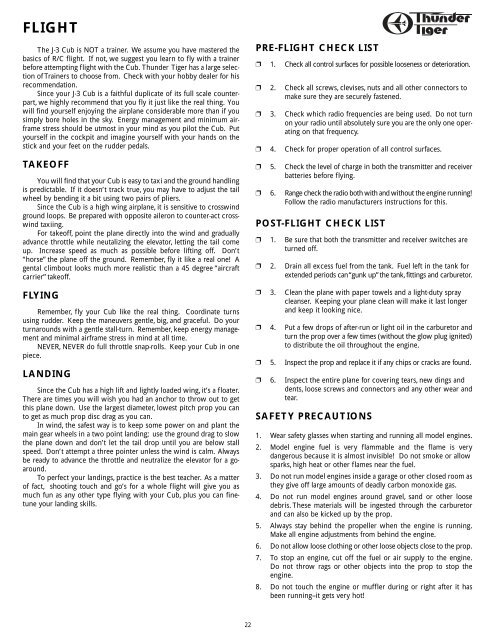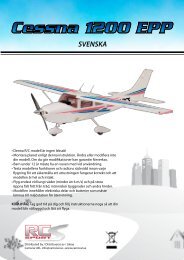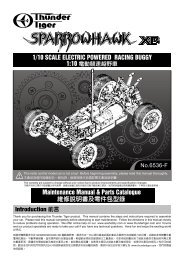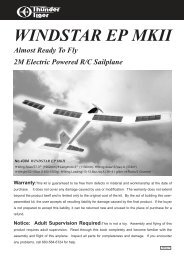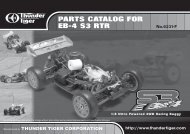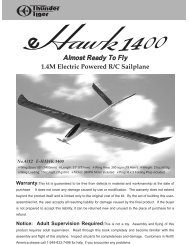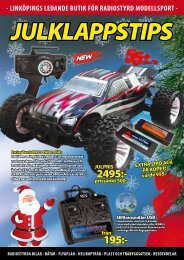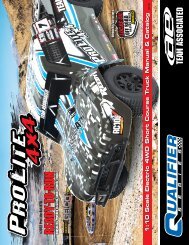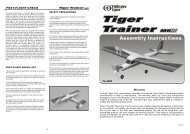Create successful ePaper yourself
Turn your PDF publications into a flip-book with our unique Google optimized e-Paper software.
FLIGHT<br />
The J-3 <strong>Cub</strong> is NOT a trainer. We assume you have mastered the<br />
basics of R/C flight. If not, we suggest you learn to fly with a trainer<br />
before attempting flight with the <strong>Cub</strong>. Thunder Tiger has a large selection<br />
of Trainers to choose from. Check with your hobby dealer for his<br />
recommendation.<br />
Since your J-3 <strong>Cub</strong> is a faithful duplicate of its full scale counterpart,<br />
we highly recommend that you fly it just like the real thing. You<br />
will find yourself enjoying the airplane considerable more than if you<br />
simply bore holes in the sky. Energy management and minimum airframe<br />
stress should be utmost in your mind as you pilot the <strong>Cub</strong>. Put<br />
yourself in the cockpit and imagine yourself with your hands on the<br />
stick and your feet on the rudder pedals.<br />
TAKEOFF<br />
You will find that your <strong>Cub</strong> is easy to taxi and the ground handling<br />
is predictable. If it doesn’t track true, you may have to adjust the tail<br />
wheel by bending it a bit using two pairs of pliers.<br />
Since the <strong>Cub</strong> is a high wing airplane, it is sensitive to crosswind<br />
ground loops. Be prepared with opposite aileron to counter-act crosswind<br />
taxiing.<br />
For takeoff, point the plane directly into the wind and gradually<br />
advance throttle while neutalizing the elevator, letting the tail come<br />
up. Increase speed as much as possible before lifting off. Don’t<br />
“horse” the plane off the ground. Remember, fly it like a real one! A<br />
gental climbout looks much more realistic than a 45 degree “aircraft<br />
carrier” takeoff.<br />
FLYING<br />
Remember, fly your <strong>Cub</strong> like the real thing. Coordinate turns<br />
using rudder. Keep the maneuvers gentle, big, and graceful. Do your<br />
turnarounds with a gentle stall-turn. Remember, keep energy management<br />
and minimal airframe stress in mind at all time.<br />
NEVER, NEVER do full throttle snap-rolls. Keep your <strong>Cub</strong> in one<br />
piece.<br />
LANDING<br />
Since the <strong>Cub</strong> has a high lift and lightly loaded wing, it’s a floater.<br />
There are times you will wish you had an anchor to throw out to get<br />
this plane down. Use the largest diameter, lowest pitch prop you can<br />
to get as much prop disc drag as you can.<br />
In wind, the safest way is to keep some power on and plant the<br />
main gear wheels in a two point landing; use the ground drag to slow<br />
the plane down and don’t let the tail drop until you are below stall<br />
speed. Don’t attempt a three pointer unless the wind is calm. Always<br />
be ready to advance the throttle and neutralize the elevator for a goaround.<br />
To perfect your landings, practice is the best teacher. As a matter<br />
of fact, shooting touch and go’s for a whole flight will give you as<br />
much fun as any other type flying with your <strong>Cub</strong>, plus you can finetune<br />
your landing skills.<br />
PRE-FLIGHT CHECK LIST<br />
❐ 1. Check all control surfaces for possible looseness or deterioration.<br />
❐ 2. Check all screws, clevises, nuts and all other connectors to<br />
make sure they are securely fastened.<br />
❐ 3. Check which radio frequencies are being used. Do not turn<br />
on your radio until absolutely sure you are the only one operating<br />
on that frequency.<br />
❐ 4. Check for proper operation of all control surfaces.<br />
❐ 5. Check the level of charge in both the transmitter and receiver<br />
batteries before flying.<br />
❐ 6. Range check the radio both with and without the engine running!<br />
Follow the radio manufacturers instructions for this.<br />
POST-FLIGHT CHECK LIST<br />
❐ 1. Be sure that both the transmitter and receiver switches are<br />
turned off.<br />
❐ 2. Drain all excess fuel from the tank. Fuel left in the tank for<br />
extended periods can “gunk up”the tank,fittings and carburetor.<br />
❐ 3. Clean the plane with paper towels and a light-duty spray<br />
cleanser. Keeping your plane clean will make it last longer<br />
and keep it looking nice.<br />
❐ 4. Put a few drops of after-run or light oil in the carburetor and<br />
turn the prop over a few times (without the glow plug ignited)<br />
to distribute the oil throughout the engine.<br />
❐ 5. Inspect the prop and replace it if any chips or cracks are found.<br />
❐ 6. Inspect the entire plane for covering tears, new dings and<br />
dents, loose screws and connectors and any other wear and<br />
tear.<br />
SAFETY PRECAUTIONS<br />
1. Wear safety glasses when starting and running all model engines.<br />
2. Model engine fuel is very flammable and the flame is very<br />
dangerous because it is almost invisible! Do not smoke or allow<br />
sparks, high heat or other flames near the fuel.<br />
3. Do not run model engines inside a garage or other closed room as<br />
they give off large amounts of deadly carbon monoxide gas.<br />
4. Do not run model engines around gravel, sand or other loose<br />
debris. These materials will be ingested through the carburetor<br />
and can also be kicked up by the prop.<br />
5. Always stay behind the propeller when the engine is running.<br />
Make all engine adjustments from behind the engine.<br />
6. Do not allow loose clothing or other loose objects close to the prop.<br />
7. To stop an engine, cut off the fuel or air supply to the engine.<br />
Do not throw rags or other objects into the prop to stop the<br />
engine.<br />
8. Do not touch the engine or muffler during or right after it has<br />
been running–it gets very hot!<br />
22


